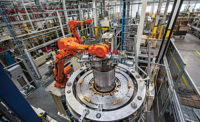FRANFURT, Germany—Manufacturers in a variety of industries around the world continue to invest heavily in robotic technology. According to the International Federation of Robotics (IFR), 553,052 industrial robots were installed in factories last year, a 5 percent increase over 2021. The majority (73 percent) of those installations were in Asia, followed by Europe (15 percent) and the Americas (10 percent).
“The world record of 500,000 units was exceeded for the second year in succession,” says Marina Bill, president of IFR. “In 2023, the industrial robot market is expected to grow by 7 percent to more than 590,000 units worldwide.”
China is by far the world’s largest market. In 2022, annual installations of 290,258 units replaced the previous record of 2021. On average, annual robot installations in that country have grown 13 percent annually since 2017.
Robot installations in Japan were up by 9 percent to 50,413. The country ranks second to China in size of the overall market for industrial robots. Japan also produces 46 percent of all robots in use worldwide.
In Europe, Germany, Italy and France had the most robots installed in 2022. Overall, Europe is the world’s second largest market, accounting for 70,781 machines.
In the Americas, installations were up 8 percent to 56,053 units in 2022, surpassing the 2018 peak level of 55,212 units. The United States, the largest regional market, accounted for 71 percent of that demand. Robot installations were up by 10 percent to 39,576 units.
The main growth driver was the automotive industry, which posted a 47 percent increase in installations with 14,472 units. The next two industries are metal and machinery industry (3,900 units) and the electrical-electronics (3,732 units).
“The year 2023 will be characterized by a slowdown of global economic growth,” says Bill. “However, robot installations this year are not expected to follow this pattern.
“There is no indication that the overall long-term growth trend will come to an end soon,” claims Bill. “Rather, the contrary will be the case. The mark of 600,000 units installed per year worldwide is expected to be reached in 2024.”






